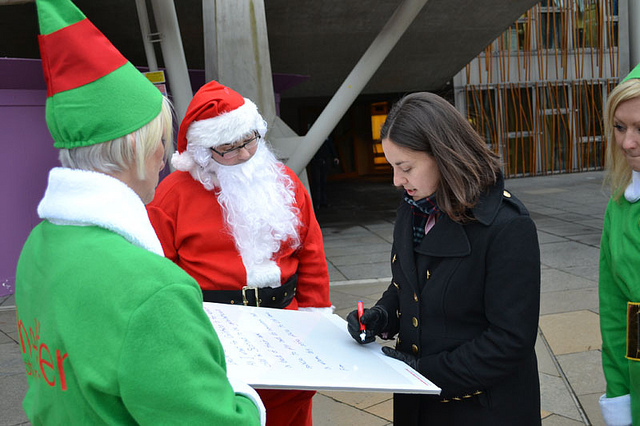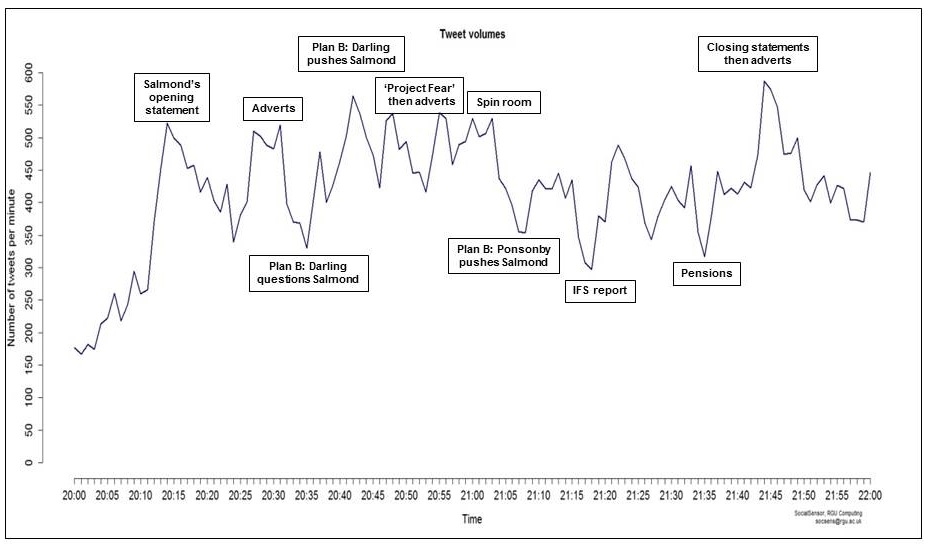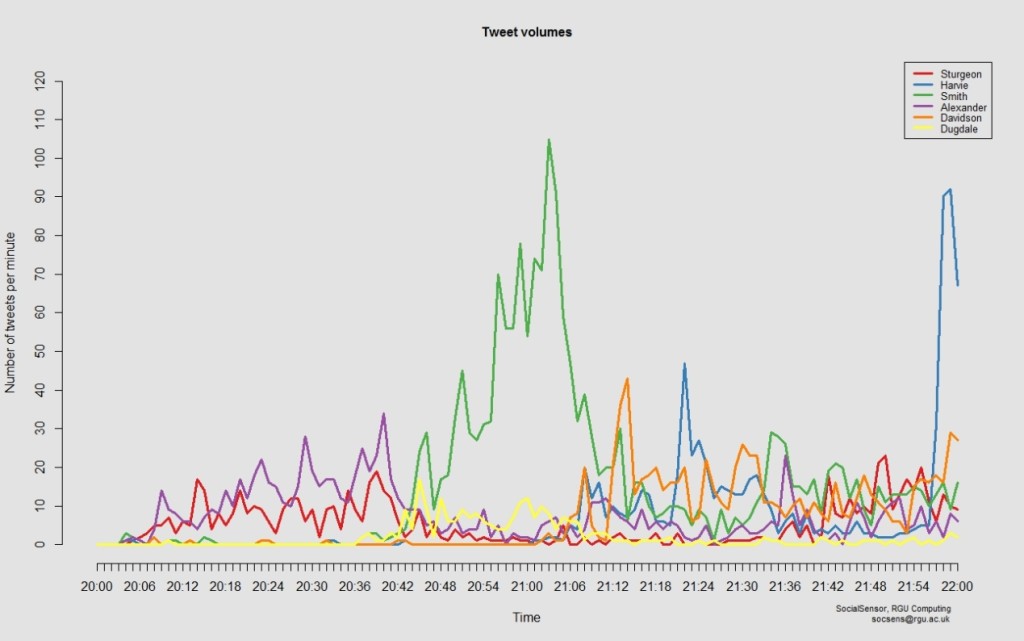Analysis of Twitter responses indicates a preference for diversity in televised political debates
In autumn 2014, during the last few weeks of the Scottish Independence Referendum campaign, researchers at Robert Gordon University explored the Twitter response to three live televised political debates, each of which involved high-profile participants. Graeme Baxter shares their findings.

Kezia Dugdale (Credit: Shelter Scotland, CC BY NC 2.0)
The first debate studied was the head-to-head between the then First Minister of Scotland, Alex Salmond, and the Better Together chairman, Alastair Darling, broadcast by Scottish Television (STV) on 5 August 2014. This was a tetchy affair, involving much shouting and finger pointing between the two men; and afterwards the general consensus in the media was that Darling had emerged the victor. The second event studied was the Salmond-Darling ‘rematch’, broadcast by the BBC on 25 August 2014. If anything, this event was more ill-tempered than the first, with even the debate’s moderator joining in the shouting at times. This time round, however, Salmond was generally regarded by the media as having come out on top.
The third debate studied was broadcast by STV on 2 September 2014 and had an altogether different format. Described as a ‘town hall debate’, this involved two teams of three people representing each side of the independence argument. For the Yes side the team was: the then Deputy First Minister, Nicola Sturgeon; the Scottish Green Party MSP, Patrick Harvie; and the actress Elaine C. Smith. The No team was: Douglas Alexander, then Labour MP; the Scottish Conservative Leader, Ruth Davidson MSP; and the Labour MSP, Kezia Dugdale. While this event attracted less media attention than the Salmond-Darling encounters, the coverage that did occur was full of praise for both the content and the format: ‘A referendum debate that showed us at our best’ (STV News).
During each of the three debates, the research team identified the peaks and troughs in Twitter usage, and then explored the topics and incidents that were the foci of these peaks and troughs. Our sample of Twitter users was compiled in three ways, from: 1) those using the neutral and widely adopted #indyref hashtag in their posts, or those hashtags promoted by the broadcasters (e.g., #ScotDecides, #BBCindyref); 2) Twitter accounts geo-tagged as based in Scotland; and 3) a group of around 300 accounts, drawn from existing Twitter lists (e.g., Scottish #indyref journos), whose owners had a clear interest in Scottish politics.
Figure 1 illustrates the peaks and troughs in Twitter traffic during the first Salmond-Darling debate (figures for the other debates, and a fuller account of the results, can be found here). When we consider the three debates as a whole, the Twitter posts followed the agenda set by the broadcasters and the politicians very closely. Thus, when the debaters discussed the potential currency of an independent Scotland, Twitter users did so also.
Figure 1: Peaks and troughs in Twitter discussion: Salmond-Darling STV debate, 5 August 2014.
While certain subjects, such as currency and oil revenues, attracted Twitter discussion during all three debates, no single policy area consistently caused the highest peaks. Instead, our sample appeared to respond most vigorously to new topics, or new debaters, in each subsequent programme. This is perhaps best illustrated in Figure 2, which shows that the relative newcomer to the political stage, Elaine C. Smith, clearly dominated the Twitter discussion when, in the middle section of the town hall event, she debated social justice issues with Kezia Dugdale MSP.
Figure 2: Actress Elaine C. Smith dominates Twitter discussion during STV town hall debate, 2 September 2014
Significantly, though, our sample also responded strongly to what might be described as moments of ‘political theatre’, such as the raised voices and aggressive questioning in the two Salmond-Darling debates, and Elaine C. Smith (perhaps summoning all her Thespian skills) making an impassioned plea for a Yes vote during the third debate. In this respect, the sample tweets were generally critical of the behaviour exhibited during the first two events, with many linking this to the debates’ all-male formats. As one Twitter user observed, this demonstrated ‘macho politics at its worst’. In contrast, the composition of the town hall debate panel (six debaters, of which four were women) was seen largely by the Twitter audience as having contributed to a far more positive viewing experience, with one declaring:
‘#ScotDecides one of best political TV debates for many a year. Informed, diverse, courteous and genuinely participatory’
More recently, in the build-up to the 2015 General Election, the research team conducted similar work during the ITV party leaders debate on 2 April 2015, and the BBC ‘challengers’ debate on 16 April 2015. Here, we collected all tweets containing the hashtags promoted by the programme makers: #leadersdebate and #BBCdebate. While detailed analysis is still in progress, our initial findings (available here) indicated that the Twitter audience reacted positively to the presence of the three female party leaders (Nicola Sturgeon, SNP; Leanne Wood, Plaid Cymru; and Natalie Bennett, Greens). Words such as ‘civilising’, ‘transforming’ and ‘refreshing’ were used regularly; and one notable peak in Twitter traffic occurred when Sturgeon suggested that they [the female leaders] were breaking up the ‘Old Boys’ Network’ at Westminster. Throughout both debates, Sturgeon was singled out consistently for individual praise on Twitter; sentiments which were echoed in the various snap polls conducted by the mainstream media in the immediate aftermath of these events.
Indeed, generally speaking, during all of the televised debates studied to date, our Twitter sample has responded immediately to onscreen events in very similar ways to the mainstream media the next morning. With this in mind, it might be argued that real-time Twitter discussion can act as a useful barometer of overall viewer opinion, and that it might assist the broadcasters and the political classes in identifying which topics, formats and behaviours engage or disengage the electorate during such programmes.
—
Note: This post represents the views of the authors, and does not give the position of Democratic Audit or the London School of Economics. Please read our comments policy before commenting.
—
 Graeme Baxter is a Research Fellow and part-time Lecturer at Robert Gordon University, Aberdeen. His research interests include: the provision and use of government, parliamentary and citizenship information; freedom of information legislation; government consultation processes; and the use of the Internet by political parties, elected members and parliamentary candidates.
Graeme Baxter is a Research Fellow and part-time Lecturer at Robert Gordon University, Aberdeen. His research interests include: the provision and use of government, parliamentary and citizenship information; freedom of information legislation; government consultation processes; and the use of the Internet by political parties, elected members and parliamentary candidates.
![]() This post is based on a presentation given by the author at the 2015 CeDem conference in Krems, Austria.
This post is based on a presentation given by the author at the 2015 CeDem conference in Krems, Austria.







 Democratic Audit's core funding is provided by the Joseph Rowntree Charitable Trust. Additional funding is provided by the London School of Economics.
Democratic Audit's core funding is provided by the Joseph Rowntree Charitable Trust. Additional funding is provided by the London School of Economics.
Analysis of Twitter responses indicates preference for diversity in televised political debates https://t.co/OCna0L3AUf HT @democraticaudit
Analysis of Twitter responses indicates a preference for diversity in … – Democratic Audit UK: Demo… https://t.co/TWwbW65ctT #indyref
Analysis of Twitter responses indicates a preference for diversity in … – Democratic Audit UK: Democratic Au… https://t.co/oRVbIZZS5b
Analysis of Twitter responses indicates a preference for diversity in televised political debates https://t.co/hLbsdX95b4
Analysis of Twitter responses indicates a preference for diversity in televised political debates: In autumn 2… https://t.co/VYgePIa3Cw
Analysis of Twitter responses indicates a preference for diversity in TV political debates | Democratic Audit UK | https://t.co/sEmEjrMJ9c |
Analysis of Twitter responses indicates a preference for diversity in televised political debates https://t.co/vLPhJB7Z0L #Option2Spoil
Analysis of Twitter responses indicates a preference for diversity in televised… https://t.co/f7xaBhHCa9 https://t.co/ZmwbZeT84e